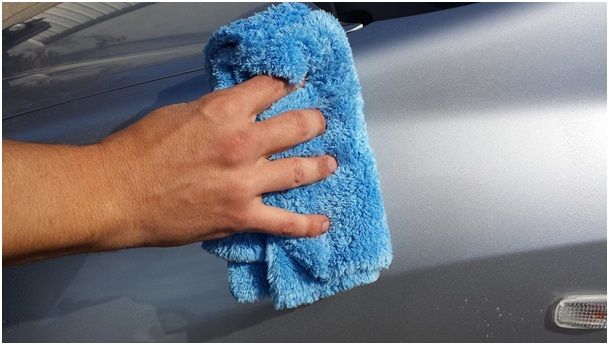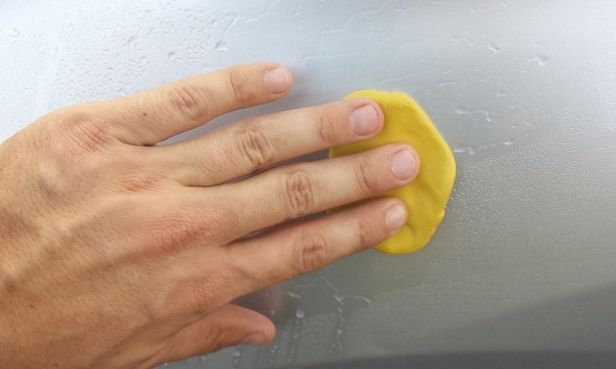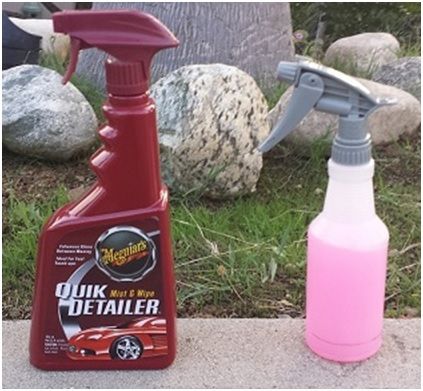Here is an article I recently wrote, talking about the varying roles of our old friend the Quick Detailer . . .
Quick Detailer Defined
Quick Detailer, QD for short , is a frequently used term casually thrown around within the car care industry. Often, car enthusiasts and professionals are able to list some uses for a QD, however there seems to be little clarification of how the product works scattered about the interwebs.
Quick detailer is a spray product that will allow for simple removal of light dust and light topical contaminants from a vehicle by lessening the friction between the vehicle surface and the media chosen to trap and remove the dust from said surface. Quick detailer is not a washing type product; rather it is a surface maintenance product that can assist in preserving the beauty of a vehicle’s finish indefinitely; as long as the dirt accumulated never rises above a simple dust level.
For anything beyond light topical dust and contamination an individual should look to using a Waterless Wash, Rinseless Wash, and or a Traditional Wash. These three wash methods, listed in ascending order of dirt level, offer different levels of aggressiveness in regards to how invasive they are toward the paint in order to assist in the removal of increased levels of topical contamination such as: environmental contaminants, road film, and industrial fallout to name a few.
It could be said that a traditional QD is a dedicated simple cleaner of sorts, as it lubricity agents are only suited for dirt removal. Therefore, on its most fundamental level, a quick detailer functions as a surfactant; adding lubricity to a surface, allowing for safe removal of dust particles from a paint surface by encapsulating the particles in a slick paint safe liquid, drastically reducing the amount of friction between the dirt particles, the surface, and the removal medium. The aspect of a QD that makes it safe and particularly effective is how the liquid acts a transport vessel, allowing the medium [a microfiber towel is best] to trap the ‘liquified’ dust particles within itself, enabling complete removal of all particles from the vehicle’s surface in the safest manner possible. It should be stated that the methodology involved in the removal of topical contamination, accompanying the use of a quick detailer, greatly increases or decreases the amount micro scratching that comes along with ANYamount of contact with a painted surface.

Because of the simple lubricity factor offered by quick detailers, they were the first natural choice for clay bar lubrication. By reducing the friction between the clay and the paint’s surface, the quick detailer allows the naturally tacky clay to effortlessly glide and contour itself over a vehicle’s surfaces, removing (by means of embedding the particles within the clay’s surface) topical contaminants that come in contact with the clay.

Besides dust removal and clay bar lubrication, QD’s have also become quite popular as a drying aid after washing; to assist in the reduction of micro-marring of the drying media against the paint’s surface and the removal of any possible water spots [and or small missed wash areas] during the drying phase.
It should be noted that a newer wave of QD hybrid products have flooded the market in the last 2-3 years. In addition to the traditional functions of a quick detailer, many of these products are sold at a high concentration so they can be diluted with for use as a Water-less wash and quick detailing duties. Some also offer temporary paint protection by imparting a protective layer [wax or hydrophobic polymer barrier] to the surface. Many of these products are formulated with a quantity of polymers that double or triple[or more]the amount of a traditional quick detailer. Some formulations also include additional surfactants, which greatly enhances gloss, allowing the new waves of QD’s a bit more versatility of use.
Although multipurpose QD’s seem to be the wave of the future, there will always be a role for the traditional quick detailer as a simple ‘light dust removal by means of simple lubricity.” This is because many conditions exist where contaminants need to be removed from paint with a small amount of lubricity, allowing the surface to remain clean and untreated during the current phase of work that is taking place.
Quick Detailer Defined
Quick Detailer, QD for short , is a frequently used term casually thrown around within the car care industry. Often, car enthusiasts and professionals are able to list some uses for a QD, however there seems to be little clarification of how the product works scattered about the interwebs.
Quick detailer is a spray product that will allow for simple removal of light dust and light topical contaminants from a vehicle by lessening the friction between the vehicle surface and the media chosen to trap and remove the dust from said surface. Quick detailer is not a washing type product; rather it is a surface maintenance product that can assist in preserving the beauty of a vehicle’s finish indefinitely; as long as the dirt accumulated never rises above a simple dust level.
For anything beyond light topical dust and contamination an individual should look to using a Waterless Wash, Rinseless Wash, and or a Traditional Wash. These three wash methods, listed in ascending order of dirt level, offer different levels of aggressiveness in regards to how invasive they are toward the paint in order to assist in the removal of increased levels of topical contamination such as: environmental contaminants, road film, and industrial fallout to name a few.
It could be said that a traditional QD is a dedicated simple cleaner of sorts, as it lubricity agents are only suited for dirt removal. Therefore, on its most fundamental level, a quick detailer functions as a surfactant; adding lubricity to a surface, allowing for safe removal of dust particles from a paint surface by encapsulating the particles in a slick paint safe liquid, drastically reducing the amount of friction between the dirt particles, the surface, and the removal medium. The aspect of a QD that makes it safe and particularly effective is how the liquid acts a transport vessel, allowing the medium [a microfiber towel is best] to trap the ‘liquified’ dust particles within itself, enabling complete removal of all particles from the vehicle’s surface in the safest manner possible. It should be stated that the methodology involved in the removal of topical contamination, accompanying the use of a quick detailer, greatly increases or decreases the amount micro scratching that comes along with ANYamount of contact with a painted surface.

Because of the simple lubricity factor offered by quick detailers, they were the first natural choice for clay bar lubrication. By reducing the friction between the clay and the paint’s surface, the quick detailer allows the naturally tacky clay to effortlessly glide and contour itself over a vehicle’s surfaces, removing (by means of embedding the particles within the clay’s surface) topical contaminants that come in contact with the clay.

Besides dust removal and clay bar lubrication, QD’s have also become quite popular as a drying aid after washing; to assist in the reduction of micro-marring of the drying media against the paint’s surface and the removal of any possible water spots [and or small missed wash areas] during the drying phase.
It should be noted that a newer wave of QD hybrid products have flooded the market in the last 2-3 years. In addition to the traditional functions of a quick detailer, many of these products are sold at a high concentration so they can be diluted with for use as a Water-less wash and quick detailing duties. Some also offer temporary paint protection by imparting a protective layer [wax or hydrophobic polymer barrier] to the surface. Many of these products are formulated with a quantity of polymers that double or triple[or more]the amount of a traditional quick detailer. Some formulations also include additional surfactants, which greatly enhances gloss, allowing the new waves of QD’s a bit more versatility of use.
Although multipurpose QD’s seem to be the wave of the future, there will always be a role for the traditional quick detailer as a simple ‘light dust removal by means of simple lubricity.” This is because many conditions exist where contaminants need to be removed from paint with a small amount of lubricity, allowing the surface to remain clean and untreated during the current phase of work that is taking place.






Comment